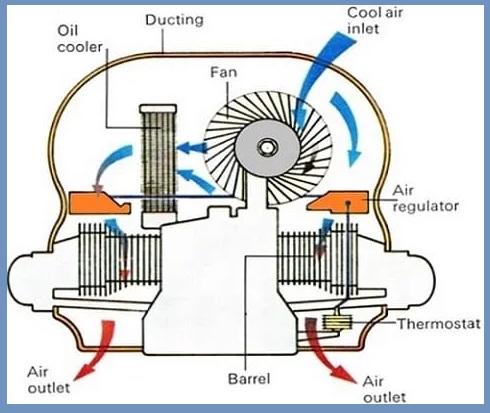An air cooled engine is a type of internal combustion engine in which air passes through the engine to cool it. Air cooled engines rely on direct airflow through the fins or hot areas of the engine to cool them to keep the engine at operating temperature.

In all combustion engines, a large part of the heat generated (about 44%) escapes through the exhaust, not through the metal fins of the air-cooled engine (12%). About 8% of the heat is transferred to the oil, which although mainly for lubrication, also serves as a heat sink through the cooler.
Most modern cars use water-cooled engines with radiators, water pumps, and hoses that circulate a mixture of water and coolant throughout the engine. The heat from the engine is transferred to the coolant, which is then cooled in the radiator and returned.
Air-cooled engines don’t want that. They rely on a good fortune from the past to put down fires. Technically, all engines are air-cooled because even water-cooled engines use air to cool the liquid in the radiator. But let’s not break the hair.
Air-cooled motors are generally used in applications not suitable for liquid cooling; As such, modern air-cooled engines are used in motorcycles, general aviation aircraft, lawnmowers, generators, outboard engines, power supplies, table saws, and generator sets Auxiliary.
Table of Contents
Working Concept of Air Cooled Engine
The air-cooled engine makes use of an air-cooled system. The primary precept of an air-cooled motor is to permit airflow via the additives from which warmness is dissipated, this relies upon the floor of the metallic withinside the touch pace of the airflow. , the temperature distinction between the new floor and the air.
The air-cooled engine makes use of fins molded into the cylinder head to deplete warmness as opposed to the use of a liquid-stuffed radiator. By removing the radiator, the air-cooled motor may be utilized in packages in which area constraints restrict the set up of a radiator.
As the engine accumulates warmness, the fins permit the wind and air to attract warmness far from the engine, like someone blowing into a bit of meal this is too warm to eat.
Design/Construction
Air cooled engines have fins extending far from the engine to hold warmness out. Cool air is then blown via the fins – typically with the aid of using a vehicle fan. For airplanes and motorcycles, the vehicle`s pace actions simply sufficient cool air via the fins to maintain the engine cool.

Some air-cooled engines can also have ducts across the engine to hold airflow to the freshest areas. Some plane engines may also even baffle structures that direct high-stress air thru the fins.
Another layout characteristic that enables preserve the temperature of an air-cooled engine low is that the cylinders are positioned contrary every different – they’re going through every different and in addition aside than in traditional water-cooled engines. This lets air float freely thru the fins. Some air-cooled engines additionally use an oil cooler to preserve the oil temperature down.
High-velocity air-cooled engines are 2-stroke engines. This form of the engine makes use of a combination of fuel and oil withinside the gasoline tank, the oil enables to chill the engine.
This configuration additionally removes big quantities of oil withinside the engine crankcase. Oil traps engine warmth and provides to the issue of cooling a 4-stroke engine. This is why many 4-stroke engines require an outside engine oil cooler to assist hold the right temperature.
Pros
- Aircooled engines don’t have coolant leakage problems.
- They heat uploads quicker than liquid-cooled engines.
- These forms of engines don’t have any chance of coolant freezing.
- They are lighter than liquid-cooled engines.
- They have an easy design.
- This engine calls for much less setup space.
Cons
- Air-cooled engines are much more likely to overheat.
- Large enthusiasts used to chill the motor can eat a variety of power
- They are extra high-priced to build.
- This engine produces extra noise than an oil-cooled engine.
- The warmth switch coefficient of the air is much less, so it really works much less efficiently.
- They require excessive maintenance.
Application/Uses
- Air-cooling structures are generally utilized in small engines, together with as much as 1520 kW, and in-plane engines.
- Air-cooled engines are utilized in scooters.
- They are utilized in airplanes and motorcycles.
- They are utilized in leisure vehicles, cars, and tractors.
